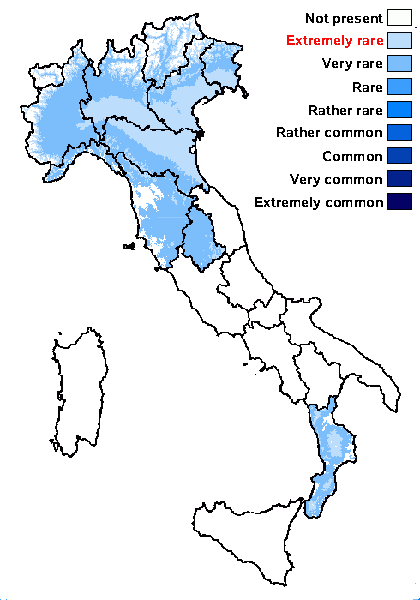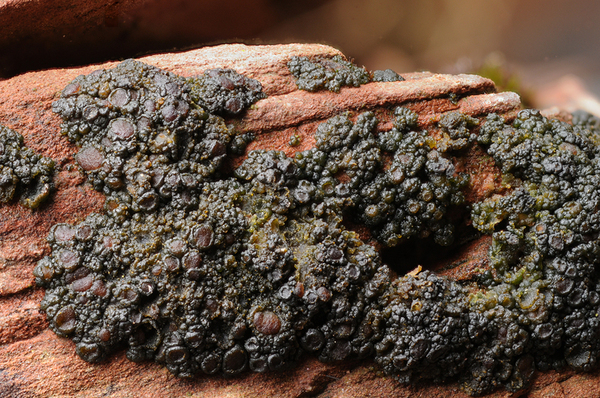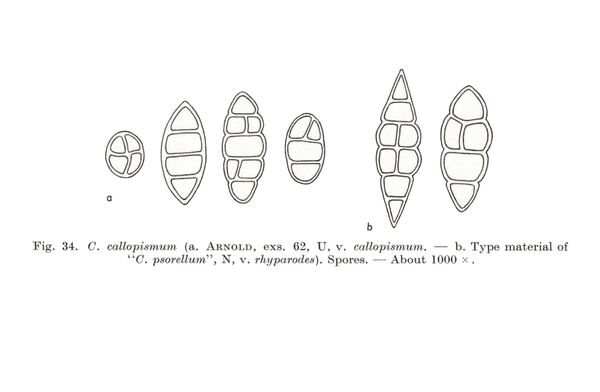Scytinium callopismum (A. Massal.) Otálora, P.M. Jørg. & Wedin
Fungal Divers. (online version), 64: 290, 2013. Basionym: Collema callopismum A. Massal. - Miscell. Lichenol.: 23, 1856.
Synonyms: Collema callopismum f. granulosum Degel.; Leptogium callopismum (A. Massal.) Harm.
Distribution: N - VG, Frl, TAA, Ven, Lomb, Piem (Isocrono & al. 2004, Isocrono & Piervittori 2008), VA (Revel & al. 2001), Emil (Fariselli & al. 2020), Lig. C - Tosc, Umb (Genovesi 2003b, Ravera & al. 2006). S - Cal (TSB 30791).
Description: Thallus subcrustose-lobulate or crustose, gelatinous when wet, usually forming up to 5 mm wide and up to 1.5 mm thick, scutelliform, subumbilicate cushions attached by a central holdfast and easily detached. Lobes few, usually repeatedly branched, 0.1-0.2 mm thick when dry, 0.2-0.45 mm thick when wet, up to 0.5 mm long and to 0.2 mm wide, contiguous, adnate or ascending, dark olive-green to black, dull, smooth to granulose. Upper and lower cortex (pseudocortex) sometimes poorly evident, or formed by 1-more layers of isodiametrical cells, the layer inbetween partly paraplectenchymatous, partly of loosely arranged hyphae. Apothecia rare, lecanorine, at first globose, later flattened and disciform, semi-immersed to sessile, 0.3-0.7 mm across, with a concave to flat, red-brown to black disc and a thin, finally sometimes excluded thalline margin. Thalline exciple ecorticate or patchily pseudocorticate; proper exciple rather thick, eupara- or subparaplectenchymatous; epithecium brownish; hymenium colourless, 90-150 µm high, I+ blue; paraphyses simple or sparingly branched in upper part, 1-5-2 µm thick at mid-level, the apical cells more or less thickened. Asci 8-spored, narrowly clavate, the apex strongly thickened, the apical dome K/I+ pale blue, with a downwardly projecting K/I+ deep blue tubular structure. Ascospores submuriform to rarely muriform, with 3-4 transverse septa and 1(-2) longitudinal septa, rarely with 3 transverse septa only, hyaline, ellipsoid, 17-26 x 8.5-10.5(-13) µm. Pycnidia laminal, immersed, paler than thallus. Conidia: bacilliform, slightly swollen at both ends, 4-5 x 1-1.5 µm. Photobiont cyanobacterial (Nostoc, the cells in short to long chains). Spot tests: all negative. Chemistry: without lichen substances. Note: a mainly western European, temperate lichen of more or less calciferous rocks, often on seepage tracks; the species was poorly understood by several Italian authors, and all Italian records, except those checked by Degelius from Veneto and Liguria (Nimis 1993: 253), need confirmation. The records from Calabria by Puntillo (1996) are excluded: the corresponding material in TSB belongs to another species.
Growth form: Foliose, narrow lobed
Substrata: rocks
Photobiont: cyanobacteria, filamentous (e.g. Nostoc, Scytonema)
Reproductive strategy: mainly sexual
On otherwise dry surfaces with short periods of water seepage after rain
Commonnes-rarity: (info)
Alpine belt: absent
Subalpine belt: absent
Oromediterranean belt: absent
Montane belt: extremely rare
Submediterranean belt: very rare
Padanian area: extremely rare
Humid submediterranean belt: very rare
Humid mediterranean belt: absent
Dry mediterranean belt: absent

Predictive model
Herbarium samples
Growth form: Foliose, narrow lobed
Substrata: rocks
Photobiont: cyanobacteria, filamentous (e.g. Nostoc, Scytonema)
Reproductive strategy: mainly sexual
On otherwise dry surfaces with short periods of water seepage after rain
Commonnes-rarity: (info)
Alpine belt: absent
Subalpine belt: absent
Oromediterranean belt: absent
Montane belt: extremely rare
Submediterranean belt: very rare
Padanian area: extremely rare
Humid submediterranean belt: very rare
Humid mediterranean belt: absent
Dry mediterranean belt: absent

Predictive model
| Herbarium samples |
 Index Fungorum
Index Fungorum
 GBIF
GBIF



